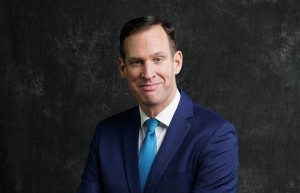Growth drivers for EU groups
How have recent declines in exports and orders impacted European businesses and their plans in Vietnam?
 |
| Gabor Fluit, chairman of the European Chamber of Commerce in Vietnam |
The impact of these declines on European businesses in Vietnam is noticeable and has contributed to a decrease in overall confidence. This is evident in the latest Business Confidence Index from the European Chamber of Commerce in Vietnam (EuroCham), which recorded a score of 43 – a figure that is even lower than during the 2012 banking crisis.
Export declines have reduced revenue for European companies, prompting lay-offs and operational reductions. Many have also had difficulty meeting customer expectations. Faced with these challenges, European businesses have reoriented their strategies to improve operational efficiency, expand into new markets, and make use of digital tools such as e-commerce to maintain sales.
As for the relocation of operations from China, our Business Confidence Index (BCI) for Q2 reveals a cautious attitude. According to the index, only 3 per cent of businesses are considering relocation from China to Vietnam, and only 2 per cent are actively planning to do so.
However, I anticipate this trend rebounding as the global economy stabilises, much like the period before the current downturn. Meanwhile, we are seeing considerable interest from European companies without an Asian presence to select ASEAN countries as their regional base instead of China.
What sectors show resilience, and which face an uphill battle?
While many different sectors show both resilience and growth potential, there are a few specific bright spots. As previously mentioned, Vietnam’s growing middle class has led to a significant increase in consumer spending. We can expect this trend to continue for decades to come. European investors are making the most of this trend by investing in food and beverages, retail, fashion, and services, for example.
With Vietnam’s skilled workforce and competitive production costs, European investors are also attracted to high-tech manufacturing sectors such as electronics, precision engineering, and advanced materials.
Still, many sectors remain untapped, and more must be done to make them reach their full potential. Renewable energy, like offshore wind, has attracted a lot of interest from European investors. However, recent power disruptions demonstrate Vietnam’s challenging energy landscape. Although the government is committed to renewable energy, the transition has been somewhat slower than what is needed for transformative change.
Vietnam’s tourism sector has shown encouraging signs of recovery. Recent visa reforms have played a pivotal role in this progress. Despite positive steps, surpassing pre-pandemic tourism levels requires more.
EuroCham is actively advocating for visa exemptions for all EU member states. This change could significantly impact tourism and boost foreign direct investment by allowing investors to visit, conduct due diligence, and meet potential partners.
Vietnam has been making efforts to improve the business climate to increase its attraction. What are the main barriers to EU businesses?
European businesses face a number of obstacles that require attention. Two particular points, however, have been problematic.
Firstly, administrative procedures continue to pose many operational challenges. The process for obtaining permits, licences, and approvals requires considerable effort, resulting in lengthy processing times and increased costs. In particular, our members and the broader foreign business community have faced many challenges as a result of Decree No.152/2020/ND-CP, which governs foreign work visas and permits.
Our members have raised this issue time and time again. I have personally spoken to quite a few investors who are unable to commit substantial amounts of capital to Vietnam because it is too difficult to bring in overseas experts to supervise projects and train local employees.
Although a draft amendment to Decree 152 was released in early August, we still have big concerns about the proposed amendment’s effectiveness in addressing key issues such as simplifying how companies report the need for foreign workers, ambiguities about the division of power between local and national authorities, and difficulties in temporarily relocating foreign employees between provinces.
Another critical issue is Vietnam’s infrastructure. Considering the fact that it is a developing country, many parts of Vietnam have insufficient transportation, energy, water supply, and IT infrastructure. This creates significant challenges for businesses and has a negative impact on the Vietnamese quality of life.
Businesses still face challenges in fully capitalising on the EU-Vietnam Free Trade Agreement (EVFTA). What are the main reasons for this?
With the BCI, we can learn more about the challenges that our members face when utilising the EVFTA.
A significant hurdle lies in administrative procedures. For instance, EuroCham members face complex and time-consuming customs clearance processes when importing or exporting goods in Vietnam. Collaboration between European and Vietnamese businesses certainly makes navigating these complexities easier. Furthermore, we will continue to work with the government to simplify administrative challenges through partnership and dialogue.
There is also a significant challenge related to the lack of awareness of the EVFTA and its advantages. As a result, businesses cannot capitalise on their opportunities. For businesses to benefit effectively from the EVFTA, governments and businesses must collaborate to deliver training on its specifics.
Additionally, by collaborating with businesses who are already familiar with the agreement, businesses can learn from the insights and experiences of others. It is critical to share knowledge, communicate, and pool resources as much as possible.
What factors are driving Vietnam’s growth prospects?
As a result of its participation in global trade agreements, Vietnam has opened its doors even wider to a diversity of global trading partners. Vietnam’s connection to the European Union’s 500 million-strong market, for example, has been strengthened significantly by the EVFTA. The effect has been the emergence of many new business and investment opportunities for both sides.
The growth of Vietnam’s middle class, projected to reach 95 million by 2030, is increasing consumption across various sectors like travel, food and beverages, education, services, and so on.
The increase in disposable income and access to consumer goods and services has created a large market for businesses to tap into. Vietnam’s commitment to sustainability is another driver. Eco-conscious innovators and foreign investors are very much attracted to Vietnam’s growing demand for green technologies, renewable energy, and circular economy initiatives.
With that, our Green Economy Forum on November 2 in Hanoi will bring together public and private sector stakeholders to discuss trends in the green economy, share insights on policy, and network with experts.
 | Visa exemptions for whole of EU would bring major benefits All European Union members are keen to fully tap into the great potential of the EU-Vietnam economic relationship. Gabor Fluit, chairman of the European Chamber of Commerce in Vietnam (EuroCham), discussed with VIR’s Tung Anh how important the expanded visa exemption is to its tourism industry and economic development. |
What the stars mean:
★ Poor ★ ★ Promising ★★★ Good ★★★★ Very good ★★★★★ Exceptional
Related Contents
Latest News
More News
- Vietnam's top 500 value-creating enterprises announced (December 27, 2025 | 08:00)
- The PAN Group shaping a better future with ESG strategy (December 26, 2025 | 09:00)
- Masan Consumer officially lists on HSX, marking the next phase of value creation (December 25, 2025 | 13:20)
- MCH to become the largest consumer stock on VN-Index (December 24, 2025 | 11:05)
- Oil and gas firms post strong 2025 results (December 22, 2025 | 17:42)
- SABECO wins multiple international beer awards (December 22, 2025 | 17:41)
- UOB sees Vietnam growth easing in fourth quarter (December 22, 2025 | 17:39)
- First members of Danang International Finance Centre revealed (December 22, 2025 | 17:39)
- Human-centred governance seen as key to AI development (December 19, 2025 | 18:19)
- Top 10 notable events of Vietnam’s industry and trade sector in 2025 (December 19, 2025 | 14:00)

 Tag:
Tag:





















 Mobile Version
Mobile Version